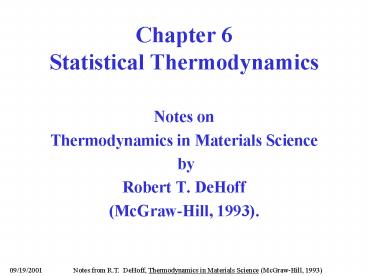Chapter 6 Statistical Thermodynamics - PowerPoint PPT Presentation
1 / 33
Title:
Chapter 6 Statistical Thermodynamics
Description:
Monatomic Gas Model. Assumptions: All particles are identical. Volume = lx x ly x lz ... of Ideal Monatomic Gases. Apply. Apply. 09/19/2001 ... – PowerPoint PPT presentation
Number of Views:556
Avg rating:3.0/5.0
Title: Chapter 6 Statistical Thermodynamics
1
Chapter 6Statistical Thermodynamics
- Notes on
- Thermodynamics in Materials Science
- by
- Robert T. DeHoff
- (McGraw-Hill, 1993).
2
Combinatorial Analysis
- Consider a system of N particles that are allowed
to occupy r states. - Microstate --- The description of the system that
provides the state of each particle. - Number of possible microstates
Macrostate --- The description of how many
particles, ni, are in each of the r
states. Number of microstates in a macrostate
3
Combinatorial Analysis
Microstates
Distribution
N3, r3
Macrostates
4
Assumptions
- Consider all particles to be identical.
- The net value of a macroscopic property depends
on the number of particles (ni) in each state
(i). Exchanging the specific identity of the
particles in a state does not change the value of
the property. - On average the fraction of time each particle
spends in any energy state is the same.
Hypothesis
Probability of a macrostate is equal to the
fraction of time the system of particles spends
in that macrostate
5
Probability of Macrostates
- Hypothesis
- Fraction of time in a macrostate
- probability of that macrostate.
6
Probability of Macrostates
Sharp distribution --- Most probable state and/or
those near it are observed most of the time.
7
Plot probability as function of fractional range.
8
(No Transcript)
9
Plot probability as function of fractional range.
10
(No Transcript)
11
(No Transcript)
12
Problem 6.4
13
Boltzman Hypothesis
- where
- S is the entropy.
- W is the of microstates in a macrostate.
- The Boltzman constant, k R/NO.
- NO is Avogardos number.
- R is the ideal gas constant.
Provides a sharp extremum. Range is compressed by
assuming logarithmic relation. Average energy of
particles is fixed.
14
(No Transcript)
15
Find Conditions for Equilibrium
- Find an expression for change in entropy of the
system. - Determine the constraints.
- Apply the constraints and the extremum criterion
- Solve the remaining equations for the
conditions for equilibrium.
16
Find an expression for dS(ni)
- Substitute for W
Expand
Note the Stirling approximation
17
Find an expression for dS(ni)
Note
and
Rearranging
Taking the derivative
18
Isolation Constraints
Consider an isolated system.
Closed system ---
Rigid system ---
Insulated system ---
19
Constrained Maximum Entropy
- Apply Lagrange multipliers to constraints add
to condition for entropy maximum.
Substitute for entropy and constraints
Rearrange, raise to power of e to yield r
equations
20
Constrained Maximum Entropy
Apply
and
Solve for a
Define
Yielding
21
Constrained Maximum Entropy
Compare phenomenological statistical
expressions for dS to evaluate a b
By analogy.
22
Constrained Maximum Entropy
Complete expression equilibrium distribution of
particles over energy levels
All equilibrium thermodynamic functions can be
derived if the partition function is known.
23
(No Transcript)
24
Thermodynamic Functions in Terms of Partition
Function
25
Thermodynamic Functions in Terms of Partition
Function
Deduce F from S
Apply
26
Thermodynamic Functions in Terms of Partition
Function
Apply
Apply
27
Monatomic Gas Model
- Assumptions
- All particles are identical.
- Volume lx x ly x lz
- Energy of the system is not quantized is equal
to S kinetic energies of the particles.
28
Thermodynamic Propertiesof Ideal Monatomic Gases
Apply
Apply
29
Thermodynamic Propertiesof Ideal Monatomic Gases
Apply
Apply
Equipartition of energy
30
Einsteins Model of a Crystal
- Consider a simple cubic crystal --- 6 nearest
neighbors, 1 atom 3 bonds per unit cell. - Hypothesis --- Energy of crystal is the sum of
the energies of its bonds. The atoms vibrate
around equilibrium positions as if bound by
vibrating springs. Only certain vibrational
frequencies are allowed in coupled springs. The
energies (ei) of the bonds are proportional to
their vibrational frequencies (n). - ei (i 1/2) hn
- where h Plancks constant.
- The adjustable parameter n is set by assuming an
Einstein temperature qE hn/k
31
Einsteins Model of a Crystal
Evaluate the partition function
Factor
Approximate as infinite series
Substitute for infinite series
32
Einsteins Model of a Crystal
Take ln of both sides
For simple cubic
Apply
Apply
33
Einsteins Model of a Crystal
Apply
Apply































